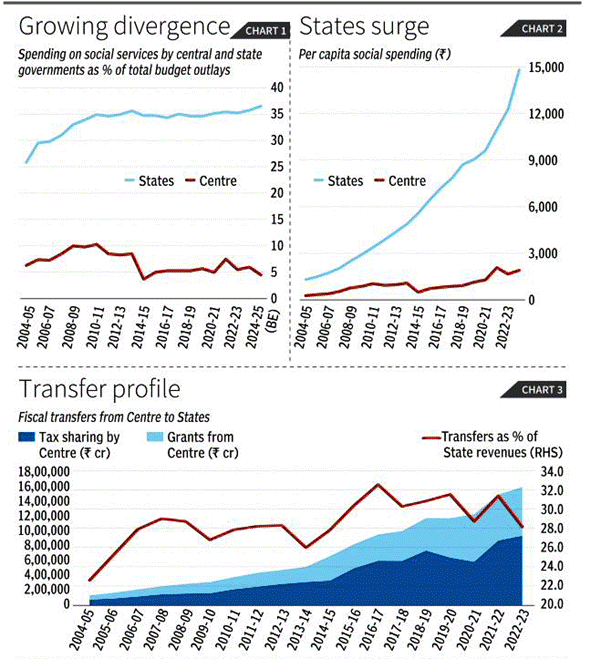Why in News ?
- Recent RBI data show that India’s rise in social spending (education, health, welfare) over the past decade has been driven mainly by State governments, despite:
- Cuts in central transfers,
- Rise in cesses & surcharges, and
- Erosion of fiscal federalism through GST and centralisation.
Relevance:
GS 2 – Governance & Welfare Schemes
• Centre–State fiscal relations and cooperative federalism
• Role of Finance Commission and GST Council in devolution
• Cesses, surcharges, and declining central transfers
• States as drivers of welfare and social sector investment
• Human capital formation through education, health, and social protection
GS 3 – Economy & Inclusive Growth
• Fiscal sustainability and social sector prioritisation
• Welfare economics and efficiency of public spending
• Impact on inequality, poverty, and inclusive development
Concept: What Is Social Spending?
- Definition: Public expenditure aimed at improving human welfare — includes education, health, nutrition, rural employment, and social protection.
- Economic Significance:
- Strengthens human capital → boosts productivity and long-term growth.
- Reduces inequality and poverty → enhances social cohesion.
- Acts as automatic stabiliser during economic shocks (e.g., COVID-19).
Historical Context
- 2004–2014:
- Massive welfare expansion — MGNREGA, NRHM, RTE, NFSA.
- Social spending averaged 8.5% of total budget.
- 2014–present :
- Continued welfare delivery but with more central branding (e.g., PMGKY, PM-Kisan).
- However, aggregate central social spending share fell to ~8%.
- Real increases came from State budgets, not Central initiatives.
Data Highlights (RBI 2023 Report)
| Indicator | 2004–14 | 2014–23 | Source |
| Central Govt. social spending (as % of total outlay) | ~8.5% | ~8% | RBI, State Finances |
| Per capita nominal social spending — Centre | ↑76% (2014–23) | — | RBI |
| Per capita nominal social spending — States | ↑397% (2014–23) | Double that of Centre | RBI |
| States’ dependence on central transfers | ↓ from 45% (2016–17) → 28.3% (2022–23) | — | RBI |
| Share of cesses & surcharges in gross tax revenue | ↑ from 10.4% → 20.4% (now ~14.5%) | — | MoF, Union Budget |

Drivers of Divergence: Why States Spent More ?
- Decentralised Demand: States face direct pressure from citizens for welfare delivery.
- Political Competition: Regional parties and State leaders (e.g., TN, Odisha, Telangana) prioritised cash transfer and welfare schemes.
- COVID-19 Shock: Forced States to spend more on health, food security, and direct aid, even with limited revenue space.
- Limited Federal Support:
- GST regime reduced States’ tax autonomy.
- Rise in non-shareable cesses/surcharges restricted revenue sharing.
- Centrally Sponsored Schemes (CSS) became more top-down, limiting local flexibility.
Federal Fiscal Imbalance
- 14th Finance Commission (2015):
- Raised States’ share in divisible taxes from 32% → 42%, a landmark reform.
- However:
- Post-2017, Centre expanded non-shareable cesses and conditional grants.
- States’ fiscal space shrank despite nominal devolution gains.
- Many CSS became politically selective, favouring BJP-ruled States.
Implications
- For Welfare Delivery:
- States remain the main implementers of welfare (education, health, PDS).
- Yet financial constraints threaten sustainability.
- For Federalism:
- Centralisation via GST & cesses erodes “cooperative federalism”, replacing it with “competitive clientelism”.
- For Political Economy:
- Despite the Centre’s image as the “welfare provider”, data show that State-led spending sustains India’s welfare model.
- Suggests political credit centralisation but fiscal decentralisation in practice.
Broader Economic Insight
- Jayati Ghosh & C.P. Chandrasekhar’s argument:
- India’s social spending success is misattributed; it reflects State efforts under fiscal duress.
- Centre’s welfare narrative (e.g., free ration, PM-Kisan) masks declining real central social investment.
- The pattern highlights asymmetric federalism — policy control at the Centre, expenditure burden at the States.
Way Forward
- Strengthen Fiscal Federalism:
- Expand tax devolution and limit cesses.
- Reform GST compensation to protect State autonomy.
- Rebalance Centre–State Relations:
- Empower States to design context-specific social schemes.
- Ensure predictable, formula-based transfers.
- Enhance Transparency:
- Disclose social spending disaggregated by sector and level of government.
- Institutionalise “Social Spending Rule”:
- Minimum threshold (say, 8–10% of GDP) for human development spending.



